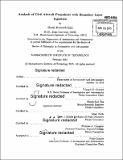Analysis of civil aircraft propulsors with boundary layer ingestion
Author(s)
Hall, David Kenneth
DownloadFull printable version (16.13Mb)
Other Contributors
Massachusetts Institute of Technology. Department of Aeronautics and Astronautics.
Advisor
Edward M. Greitzer.
Terms of use
Metadata
Show full item recordAbstract
This thesis describes (i) guidelines for propulsor sizing, and (ii) strategies for fan turbomachinery conceptual design, for a boundary layer ingesting (BLI) propulsion system for advanced civil transport aircraft. For the former, configuration performance analysis shows BLI yields a reduction in mechanical power required to propel a given aircraft. For the latter, fan turbomachinery design attributes are identified to mitigate the impact of BLI inlet distortion on propulsor performance. The propulsion system requirements are determined using a mechanical energy analysis, in which the performance of the airframe and propulsor are characterized in terms of sources and sinks of power. Using this framework, the propulsor can be sized based on the performance of the isolated airframe. Analysis of the power savings due to BLI (from reduction of viscous dissipation both in the aircraft wake and the propulsor jet) leads to scaling choices for the sizing of propulsor simulators for wind tunnel experiments to assess BLI benefit. Fan stage distortion response is assessed computationally for a range of turbomachinery design parameters and for distortions characteristic of BLI. The numerical results show the importance of three-dimensional flow redistribution upstream of the fan, and indicate that, for the parameters examined, non-axisymmetric fan stators have the largest effect on decreasing blade row velocity distortions and thus mitigating losses due to flow non-uniformity.
Description
Thesis: Ph. D., Massachusetts Institute of Technology, Department of Aeronautics and Astronautics, 2015. Cataloged from PDF version of thesis. Includes bibliographical references (pages 113-116).
Date issued
2015Department
Massachusetts Institute of Technology. Department of Aeronautics and AstronauticsPublisher
Massachusetts Institute of Technology
Keywords
Aeronautics and Astronautics.